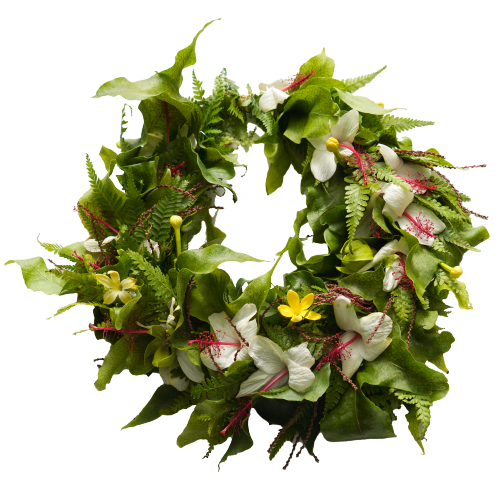We work across five botanical gardens and throughout the tropics to grow a brighter tomorrow for plants and all they sustain. We do so through a biocultural approach, where Indigenous knowledge, community priorities, and scientific research guide our path forward. Together, we will restore flourishing relationships between plants, people, and places.

These five strategic priorities guide our focus, bringing together our diverse gardens and programs to achieve greater impact for tropical plants and the ecosystems and communities they support.
Biocultural Conservation & Science
To realize lasting change for tropical plants, we must center our conservation efforts around our communities and recognize the deep connections that indigenous communities have forged with cherished plants and places. We aim to honor, learn from, and help protect those relationships for future generations of plants and people.
1
Fewer plants threatened by extinction
2
More ecosystems restored to abundance
3
Conservation of tropical crop diversity and associated cultural knowledge
4
Preservation of cultural and historical sites, knowledge, and practices
5
Improved understanding of the origin and distribution of plant diversity
6
Comprehensive conservation assessments
7
Effective biocultural conservation approaches and tools

This extraordinary lei weaves together iconic plants with deep connections to people and places in our communities. Pāpala, lauaʻe o Makana fern, ʻālula, and kokiʻo keʻokeʻo are all cherished plants of Limahuli Garden & Preserve. Ylang ylang, a vine of Allerton Garden and The Kampong, threads throughout. The ferns were grown in our Fern Lab in McBryde Garden. The lei was created by Angelina Kissida.
Horticultural Excellence & Stewardship of Living Collections
We aim to steward diverse, flourishing gardens that offer greater connection to the world of tropical plants and support conservation efforts at the same time.
1
Beautiful and thriving display gardens
2
Genetically diverse and well-curated collections
3
Effective conservation through collaboration

Leaf sheaths of ʻulu (breadfruit), symbolizing growth, form the backbone of this lei and come directly from Kahanu Gardenʻs breadfruit collection. Ribbons of kō (sugarcane) are interwoven to represent excellence. The lei was created by Shaelynn Day.
Deepening peopleʻs relationship with plants through education & public engagement
To encourage people to support and care for plants, we need to help them better understand and appreciate plant life. Our goal is to deepen people’s understanding of and empathy towards plants, raising awareness about the critical need to protect rare and endangered species.
1
Increased appreciation for tropical plants and cultural heritage
2
More sustainable conservation behaviors
3
More advocates for tropical plants and biocultural conservation
4
More people pursuing careers in plant conservation

This dazzling lei includes kukui flowers to symbolize enlightenment, ‘awa leaves to represent community, pili grass for interconnectedness, and royal poinciana for the flame of knowledge. The latter is a tree that was introduced to the U.S. through Dr. David Fairchild of The Kampong. Plant material was gathered from Limahuli Garden and McBryde Garden. The lei was created by Lei Wann.
Financial Sustainability & Longevity
Our financial health must be as strong and resilient as the plants we care for to ensure NTBG thrives into the future.
1
Achieve the optimum budget to accomplish our strategic priorities
2
A budget that allows us to build our reserves
3
Increased capacity to invest in improvements and opportunities
4
Increased public awareness, engagement, and support for NTBG

This lush lei poʻo (head lei) incorporates koa leaves to signify strength and aʻaliʻi fruits for resiliency. Plant material was collected from McBryde Garden and the lei was created by Mahea Hoʻokano.
Thriving Work Environment
An organization cannot thrive if the staff are not thriving. As we take steps in our journey for diversity, equity, inclusion, and justice, supporting our staff is foundational.
1
Improved staff retention and appropriate staffing levels
2
A workforce that is motivated, safe, and efficient
3
High-quality staff
4
Strong volunteer and intern programs

This special lei weaves our staff, communities, and places together from Hawaiʻi to Florida. Two types of kou blossoms form this lei: the lighter orange is Cordia subcordata of Hawaiʻi and the darker orange is Cordia sebestena of South Florida and the American tropics. The lei was created by Mahea Hoʻokano.
We believe as an organization headquartered in Hawaiʻi, we must strive to embody the universal ideal of Aloha. Our interactions will be respectful and empathetic. We will express gratitude and nurture those around us.
We believe it is vital to honor the ancestral knowledge and cultural legacies that have shaped our world. We steward the lands we are responsible for with dedication to generations past, present, and future.
We believe we must embrace our communities and the spirit of inclusion. We are an ‘ohana (family) – of people, plants, and places with diverse backgrounds, whose futures are deeply interdependent. We recognize it is everyone’s right and responsibility to care for our shared environment.
We believe understanding the profound challenges facing tropical plants gives us the ability to realize profound solutions. We must boldly explore, inspire wonder, and persevere.
We believe it is imperative to strive toward excellence in all of our endeavors. In this journey, we will hold ourselves and each other accountable to ethical work practices, personal integrity, and achieving our mission.